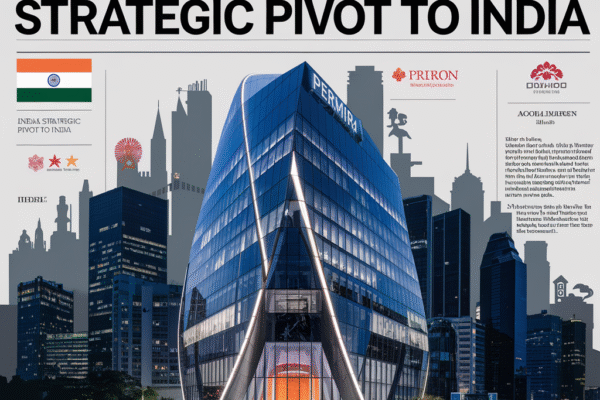Harvard University’s $53 billion endowment has entered advanced negotiations to sell approximately $1 billion in private equity fund interests through a secondary market transaction with Lexington Partners, advised by Jefferies Financial Group[1][2][7]. This strategic liquidity move comes amid heightened market volatility driven by geopolitical tensions and shifting trade policies, though university officials emphasize the divestment forms part of long-term portfolio rebalancing rather than reactionary measures[4][10]. The transaction follows Yale University’s parallel exploration of private equity sales advised by Evercore[1][7], signaling a broader institutional trend toward optimizing alternative asset exposure while maintaining operational flexibility.
Deal Architecture and Strategic Imperatives
Portfolio Rebalancing Through Secondary Markets
Harvard Management Company (HMC) maintains a 39% allocation to private equity as of 2024, up from 34% in 2021 when it executed a similar $1 billion secondary sale[1][7][10]. The current divestment allows HMC to crystallize gains from vintage funds while avoiding forced distribution delays common in traditional private equity exits. Secondary transactions have emerged as critical tools for endowments seeking to manage the “denominator effect” – when public market declines artificially inflate private asset allocations – without sacrificing long-term return targets[6][11].
Liquidity Buffers Against Macroeconomic Uncertainty
The sale coincides with Harvard’s $750 million debt issuance earlier this month, creating a combined $1.75 billion liquidity cushion[1][5][9]. While administration officials deny direct linkage to federal funding threats, the moves provide operational flexibility amid President Trump’s proposals to withhold research grants and student aid over campus policy disputes[4][5][7]. For context, Princeton University recently tapped bond markets for $320 million following federal grant freezes[5], illustrating sector-wide balance sheet stress.
Industry Context: The Secondary Market’s Ascendance
Institutional Adoption of GP-Led Continuation Vehicles
Lexington Partners’ potential acquisition reflects the $130 billion secondary market’s maturation, where experienced buyers like Ardian and Blackstone Secondary Fund now compete to provide liquidity for limited partners. GP-led continuation funds accounted for 58% of 2024’s $104 billion secondary volume, enabling institutions like Harvard to selectively exit positions while maintaining exposure to top-performing managers[6][11]. This structured approach contrasts with Yale’s rumored strip-sale approach via Evercore, which may indicate differing views on remaining manager exposure[1][7].
Consulting Firm Perspectives on Portfolio Optimization
McKinsey’s 2024 Endowment Benchmarking Report highlights that top-quartile performers maintain 35-45% private equity allocations through disciplined recycling of mature positions into new vintages[6][11]. Bain & Company analysis suggests secondary sales now account for 22% of all private equity exits, up from 9% pre-pandemic, driven by LPs’ need to rebalance portfolios amid delayed IPOs and M&A[6][11]. HMC’s move aligns with this best-practice framework, preserving capacity to commit to emerging managers in technology and life sciences.
Leadership and Structural Considerations
Governance in Politicized Climate
Harvard’s divestment process, initiated in late 2024, demonstrates HMC’s operational independence despite mounting political pressures[1][7][10]. The endowment has maintained investment discipline through multiple administrations, growing its private equity book from $18 billion to $20.7 billion since 2021 despite $2 billion in secondary sales[1][7]. This contrasts with public pension funds like CalPERS, which face legislative mandates to reduce alternative allocations.
Transaction Mechanics and Counterparty Risk
Jefferies’ selection as advisor leverages its specialty finance expertise, having structured $4.2 billion in secondary transactions during 2024’s first quarter[1][7]. Lexington Partners brings deep experience in complex LP stake acquisitions, having closed $7.8 billion in university endowment deals since 2020[1][11]. The transaction’s secondaries structure likely involves a portfolio discount of 8-12% to net asset value, consistent with recent trades of mature buyout funds[6][11].
Market Implications and Risk Factors
Signaling Effects Across Institutional Investors
Harvard’s move may accelerate secondary activity among peer endowments currently holding $23 billion in mature private equity positions, per Preqin data[6][11]. However, mass divestments risk creating buyer’s markets – secondary funds currently hold $152 billion in dry powder, but concentrated selling could pressure pricing[11]. Smaller endowments without Harvard’s scale may struggle to achieve comparable execution terms.
Trade Policy and Portfolio Contagion
While HMC maintains the sale isn’t tied to Trump’s trade wars, the administration’s 15% tariff proposal on Chinese tech imports has depressed valuations across venture capital portfolios[1][7][10]. The Technology Select Sector SPDR Fund (XLK) has declined 12% year-to-date, potentially creating new denominator effect pressures if public markets weaken further[6][11].
Conclusion: Strategic Prudence in Uncertain Times
Harvard’s calculated divestment exemplifies sophisticated liquidity management at scale, providing a template for institutions navigating bifurcated markets. As secondary transactions become central to portfolio governance, endowments must balance short-term cash needs against long-term return objectives. The coming quarters will test whether current pricing reflects fundamental value or a broader repricing of private assets – making disciplined execution critical for preserving institutional wealth through the cycle.
Sources
https://theedgemalaysia.com/node/753003, https://anewz.tv/world/world-news/6154/harvard-endowment-in-talks-to-sell-1b-in-private-equity-hol/news, https://clubs.london.edu/web/rsvp_boot?id=41441, https://timesofindia.indiatimes.com/world/us/harvard-in-talks-to-sell-1billion-in-private-equity-holdings-amid-president-donald-trumps-threats-report/articleshow/120601205.cms, https://www.ndtv.com/world-news/harvard-university-seeks-to-sell-1-billion-in-private-equity-stakes-report-8250388, https://www.saastr.com/rise-private-equity-saas-gift-founders/, https://economictimes.indiatimes.com/news/international/world-news/harvard-university-said-to-be-exploring-1-billion-of-private-equity-stakes-sale/articleshow/120602080.cms, https://www.wgu.edu/content/dam/wgu-65-assets/western-governors/documents/institutional-catalog/2021/catalog-November%202021.pdf, https://www.jpost.com/breaking-news/article-851452, https://report.az/en/amp/other-countries/harvard-university-exploring-1b-of-private-equity-stakes-sale/, https://cardiovascularbusiness.com/topics/healthcare-management/mergers-and-acquisitions/private-equity-medtronic-7b, https://www.marketscreener.com/quote/stock/EVERCORE-INC-30993/news/Harvard-University-exploring-1-billion-of-private-equity-stakes-sale-source-says-49713602/, https://theedgemalaysia.com/author/Pritam%20Biswas%20&%20Ateev%20Bhandari?page=1, https://www.13dmonitorconference.com/SummitCoverage





